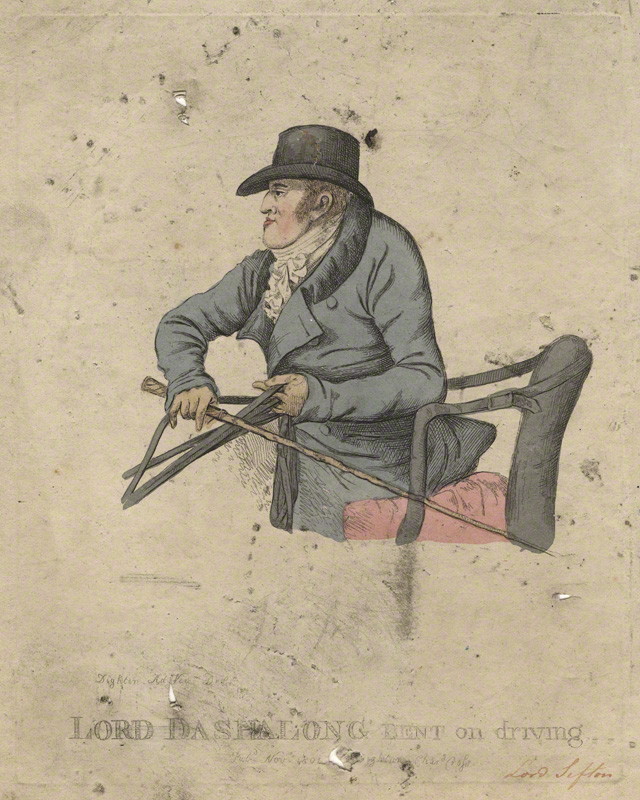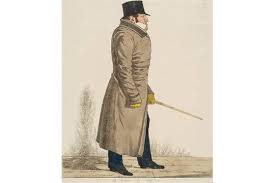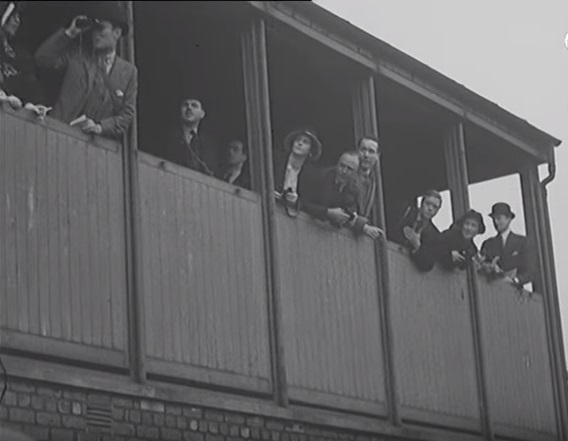The first Grand National was held in February 1839. The original advertisement inviting architects to send their designs for St George’s Hall, Liverpool, was put in the national press in March that year.
The race was held on land owned by the Earl of Sefton. The Earl of Sefton, a local aristocratic landowner, was a member of the syndicate that had been formed to create a Grand Liverpool Steeplechase which would become known as the Grand National. Sefton was joined in this syndicate by the Earl of Eglington, the Earl of Wilton, Lord George Bentinck and the 13th Earl of Derby and his son Lord Stanley (who later became the 14th Earl of Derby).
In the Great Hall of St George’s Hall there is a statue of the 14th Earl of Derby.
Instrumental in the founding of the Grand National was local hotelier and entrepreneur William Lynn who originally leased land in Maghull, and then Aintree, from Lord Sefton in 1829 for the purposes of horse racing (initially flat racing). Lynn was also responsible for the construction of a grandstand at Aintree for spectators. Lynn remained as the secretary for the Aintree Race Company until 1843.

by and published by Robert Dighton, hand-coloured etching, published November 1801
(Picture: 2nd Early Lord Dashalong)
The architect of St George’s Hall was Harvey Lonsdale Elmes. Elmes was only 25 years old when he drew his designs of St George’s Hall which became the basis for the building that exists today. He lived and worked in London but was a frequent visitor to Liverpool to superintend the building of St George’s Hall. Elmes’s hotel of choice when he stayed in Liverpool for these visits was William Lynn’s Waterloo Hotel which stood on Ranelagh Street near to Liverpool Central Railway Station.
William Lynn was also renowned for his imported ice from America and his turtle soup. He would sell both turtles and turtle soup to customers across the UK. William Lynn’s culinary expertise was famous and he was the official supplier of catering to Liverpool’s town council for civic banquets.
St George’s Hall was officially opened on Monday 19 September 1854 with construction having commenced in 1841. The winner of the Grand National in 1854 was Bourton.

St George’s Hall was also designed to house the law courts of Liverpool and in Court Number One, just next door to the Great Hall, between the years 1851 and 1954 135 people were sentenced to death and subsequently hanged at either Kirkdale prison or Walton gaol (Liverpool’s prisons).
One unfortunate individual who experienced being given the death sentence in Court Number One, St George’s Hall, was an American heiress named Florence Maybrick in one of the most famous famous trials of the nineteenth century.
In 1889 Maybrick stood trial in this building accused of murdering her husband, James, by means of poisoning by arsenic. Florence and James Maybrick lived in Battlecrease House, Aigburth (south of Liverpool city centre) sharing an unhappy and abusive marriage. James Maybrick would often physically attack and beat his wife. To the outside world, however, James and Florence were affluent, well-to-do, members of Liverpool society.
Florence Maybrick had embarked upon an extra marital affair in early 1889 with a Liverpool cotton broker, Alfred Brierley and in March that year they stayed together in a London hotel for 3 consecutive nights under the name of “Mrs Thomas Maybrick”. In late March Florence attended the Grand National at Aintree Racecourse and spent most of her time with Brierley walking arm-in-arm with him. This despite James Maybrick’s presence at the event. Other racegoers commented on it to James Maybrick and that evening, upon returning home, he physically assaulted his wife. The result of this assault was for Florence a black eye and a torn dress. Her husband attempted to throw her out of the house but their servants intervened to prevent her ejection.
In the weeks that followed James became ill and eventually died on 11 May 1889. James Maybrick was a well-known hypochondriac who would take numerous patented medicines and was even known to take small quantities of arsenic which he believed acted as an aphrodisiac. Members of James Maybrick’s family had already become suspicious of Florence when they read a letter written by her to Alfred Brierley apparently revealing her infidelity. A nurse who had been employed by James and Florence to provide care for James also witnessed Florence putting a white powder into a bottle of meat juice that was next to James’s bed. Later tested by a doctor, this bottle was found to have contained arsenic. The medical examinations of James’s body only contained a tiny amount of arsenic but Florence was arrested regardless of this.
At the trial, commencing 31 July 1889, the prosecution put forward the argument that Florence had administered the poison by means of a solution made from dipping fly paper in water. Her counsel, Sir Charles Russell, highlighted the contradictory medical evidence and the prosecution’s failure to fix a certain cause of death and argued that Maybrick did not die by arsenic poisoning but of gastroenteritis caused by chemical irritation. Maybrick had, during his final illness, been given administered strychnine, arsenic, jaborandi, cascara, henbane, morphia, prussic acid, papaine, iridin, and other medicine.
In the summing up of the trial the judge, Sir James FitzJames Stephen, made a number of muddled statements and even referred to the ‘Grand National something. I don’t know if it is a race or a steeplechase or what it is.’
On 7 August Florence Maybrick was convicted and sentenced to death. After public outcry Henry Matthews, the home secretary, and Lord Chancellor Halsbury concluded ‘that the evidence clearly establishes that Mrs Maybrick administered poison to her husband with intent to murder; but that there is ground for reasonable doubt whether the arsenic so administered was in fact the cause of his death’. Her death sentence was commuted to a life sentence.
She was released from prison in 1904 and returned to America.
The only other time Florence is known to have visited Liverpool was when she was seen at the Grand National in 1927.
Interesting fact: James Maybrick is a Jack the Ripper suspect.
King George V and Queen Mary
King George V throughout his reign (and previously as Prince of Wales) was an enthusiastic racegoer and frequently attended the Grand National. When he visited Liverpool on these occasions he would stay at Knowsley Hall, the home of the Earl of Derby. The Earl of Derby during George V’s reign was the 17th Earl and was the eldest son of the 16th Earl of Derby, whose statue stands in the Great Hall of this building.

Pictures Prince of Wales Grand National Sefton’s box
Sir James Sexton, the leader of the National Union of Dock Labour, and Labour MP for St Helens 1918-1931, was a close associate of the 17th Earl of Derby and he attended a banquet with King George V at Knowsley Hall the evening before the Grand National. The Earl of Derby revealed to the king how James Sexton, as a boy, had frequently trespassed on the earl’s estate for poaching. The king was entertained by the idea of this former poacher being formally invited to a banquet with royalty! According to Sexton, the king gave him a tip for the Grand National and he won!
In 1924, while visiting Liverpool for the Grand National, Queen Mary visited St George’s Hall.
The British thriller, Grand National Night, written by Henry Hawley Smart, and made into a film in 1953, was filmed in part at the Adelphi Hotel just across the road from St George’s Hall.
Written by James O’Keeffe MA, Visitor Services